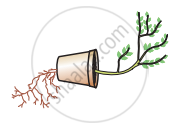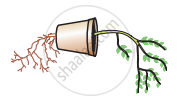Advertisements
Advertisements
प्रश्न
In the given figure (a), (b) and (c), which appears more accurate and why?
 |
 |
 |
| (a) | (b) | (c) |
उत्तर
Figure (a) appears more accurate as roots are showing positive geotropism and negative phototropism and moving towards the earth and away from the light. While the shoot is showing negative geotropism and positive phototropism moving away from the earth and towards the light source.
APPEARS IN
संबंधित प्रश्न
What is the stimulus in thigmotropism?
What does a stem (or shoot) do in response to light? What is this phenomenon known as?
The climbing organs of plants like tendrils grow towards any support which they happen to touch and wind around the support. This is an example of :
(a) chemotropism
(b) nastic movement
(c) thigmotropism
(d) geotropism
Dandelion flowers open the petals in bright light during the daytime but close the petals in dark at night. This response of dandelion flowers to light is called:
P, Q, R and S are four major types of phytohormones. P is a phytohormone which functions mainly as a growth inhibitor. It promotes the wilting and falling of leaves. Q, R and S are phytohormones which all promote growth of plants in various ways. Q is responsible for the phenomenon of phototropism in plants. R is involved mainly in shoot extensions. The phytohormone S helps in breaking the dormancy of seeds and buds. What are P, Q, R and S? Give one reason each for your choice.
When the leaves of a sensitive plant are touched with a finger, they fold up and when light fades at dusk, the petals of a dandelion flower close.
State one way in which the above two processes are similar.
The shoot system grows upward in response to ______.
Write the scientific terms used to represent.
Leaves fold up and droop in touch-me-not plant Mimosa pudica
While conducting experiments to study the effects of various stimuli on the plants, it was observed that the roots of plant X grow and bend towards two stimuli A and B but bend away from a third stimulus C. The stem of the plant X however bends ” away from stimulus A and B but bends towards the stimulus C. The stimulus B is known to act on the roots due to factors related to Earth. Keeping these points in mind, answer the following questions:
- What could be stimulus A?
- Name the stimulus seen in B.
- What could be stimulus-C?
Where are auxins synthesized in a plant? Which organ of the plant shows:
- Positive phototropism
- Negative geotropism
- Positive hydrotropism
